Lets get started using National Instrument entry-level data acquisition devices namely the USB-6000, USB-6001, USB-6002 or USB-6003, with SAFE. In this guide I will show you on how to setup your NI USB DAQ to do a simple voltage measurement and show display the result. I will throughout use the NI USB-6001 device however if you have another in the 6000 series then you can still follow this guide as the steps are the same.
Connect your computer and NI USB-6001
Before you start you should connect the NI USB-6001 device to your computer and ensure that any driver necessary is installed. Usually it will be installed automatically.
Create a blank SAFE project
When the device and computer has been connected, open SAFE and create a new project in the menu under File --> New Project in the top left corner. Then create a blank project.
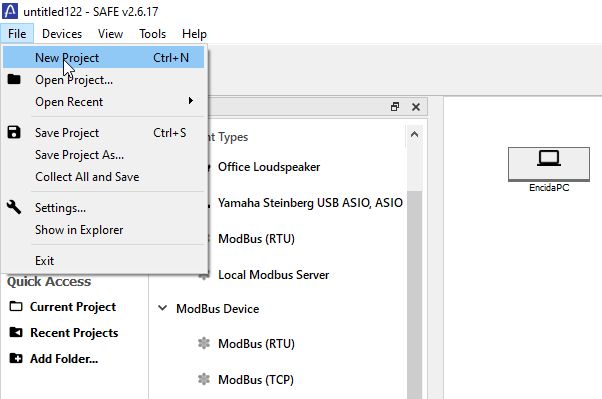
Configure your NI USB-6001 device
To configure your NI USB-6001 device click and drag a USB-6001 (Dev1), or something similar, onto the board. You can find it in your Equipment Types under NI Frontend. NOTE: if there is no cable between the device and the computer on the board the physical connection is probably not correct. Check your device manager to see if it has been connected
With the NI device on the board click it. To your right you can see the device properties. Here you can name the device and it is here we need to configure it. For the NI device there are 4 settings that are important. The first is the Sample Rate and Block Size which you can find under Devices --> Dev1. For the purpose of this guide I will set the sample rate to 100 Hz and block size to 10. So the device will gather 10 samples before sending them to SAFE with a sample rate of 100 samples per second.
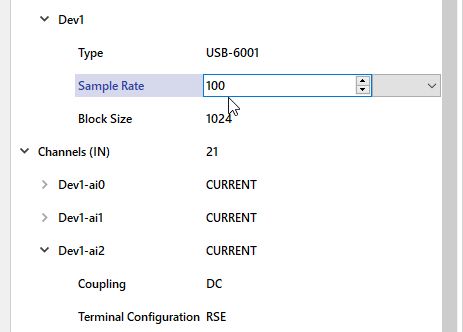
The two other settings that are important is the Channel Type and Terminal Configuration. The channel type is set to Current here for my analog inputs (ai0, ai1, etc.) We are going to switch the channel type to Voltage. We are also not interested in measuring differentiated voltages between inputs so the Terminal Configuration should be set to RSE.
Connect Voltage Probe
To measure voltage we must connect a voltage probe. So click and drag a Voltage probe, onto the board. You can find it in your Equipment Types under Sensors. Then we are going to connect the voltage probe with the analog input we have configured to measure voltage with.
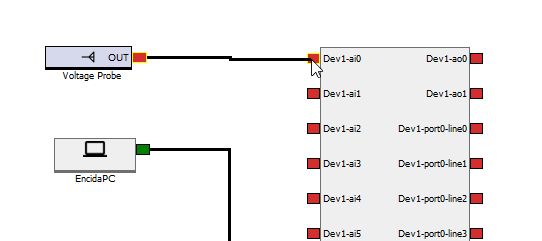
Creating a measurement procedure
To create a measurement procedure you must go to the the category "Measurement". You do this all the way to the left by clicking on Measurement. Now you can see your empty procedure with a single step. In order for the procedure to do something you must drag in a measurement tool into a step.
Start by opening the Voltage probe Tool, and click and drag out the *Analog measurement track into step 1. In Step 1 the analog measurement track will now show and you can see the electrical signal in the small real-time view on the track
Starting a test
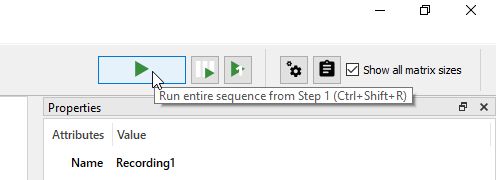
To start a test click the big play button in the top right corner and wait until the measurement is done.
1, 2, 3, 4, 5..
You have now performed your first measurement!
Processing data
With a successful measurement you must process the data and show it in the analysis dashboard. To process data you should proceed to the Processing category to the left in the same way you went to the Measurement category. On the Processing board you can see a single block named "Step 1" with and output named "RecordingTrack1". This block contains the data you just measured.
To show this data you need a plot which you can find to the right in Processing Types under Plots. Here click and drag out a "Line Plot" onto the board. With the plot on the board connect a line between the data block and the line plot by click and dragging on the output of the data block.
As you can see to the left in Processing Types there are tons of different processing blocks you can use but we will skip that for now.
Displaying data
Every block in the Plots type can be used for displaying data in some form. To display data you must go to the last category Analysis all the way to the left. Here the plots appear as results to the left where you should be able to see the "LinePlot0". Click and drag the LinePlot0 out onto the analysis board.
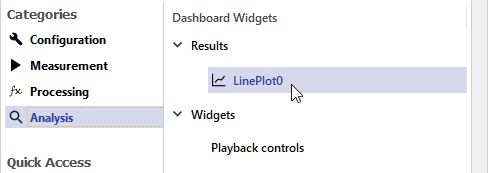
The plot appears but is empty. That is because you must compile the data. You do this by pressing on the compile button which look likes two cogwheels up in the top right corner or press Ctrl + Shift + P. Now your data appears in the plot and you have displayed your first data.
Congratulation you have made it through your first test!